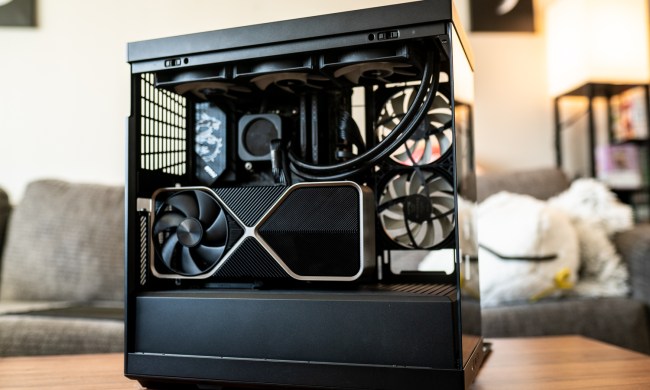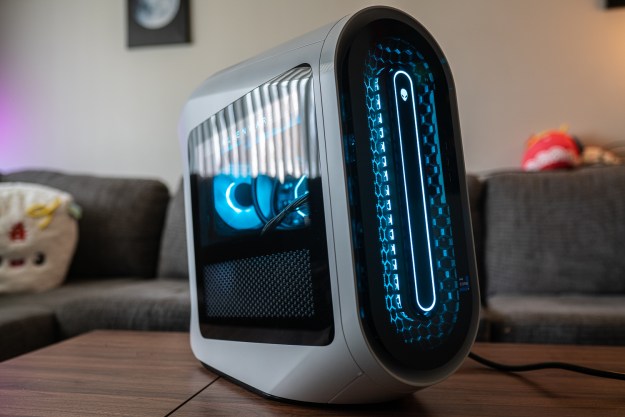
“Upgraded cooling and next-gen components bring the Alienware Aurora R15 up to the level of the best gaming desktops”
- Massive configuration options
- Cool and quiet operation
- Up to an RTX 4090 GPU
- Faster DDR5 memory options
- Mostly tool-less servicing
- Proprietary design limits upgrades
- Overreaching software
The Alienware design has become iconic, but it hasn’t always aligned with recent trends in PC building, which is why it’s slowly fallen off of the list of the best desktops. The Aurora R15 looks like the same machine we’ve had for several generations, just with updated components under the hood, but it’s a deceptively big update to Alienware’s storied gaming desktop.
A larger liquid cooler helps the machine stay cooler and quieter than any previous Alienware desktop, and the careful tweaking of the design makes upgrades much easier than they previously were. Some old habits still die hard, but there’s no denying that the Aurora R15 is an impressive next step for Dell-owned Alienware and a performant monster of a gaming PC.
Alienware Aurora R15 specs

The Alienware Aurora R15 is a machine you can configure in virtually any way you want. The base configuration starts with an Intel Core i5-13400F and RTX 3050 for $1,650, but you can go much further; up to 64GB of DDR5 memory, 6TB of storage, and a Intel Core i9-13900KF or AMD Ryzen 9 7950X.
You have a wide range of graphics options, from Nvidia’s lowly RTX 3050 and AMD’s RX 6500 XT, all the way up to an AMD RX 6900 XT or Nvidia RTX 4090. The prices aren’t bad for last-gen GPUs, either, but I have a bone to pick with the two RTX 40-series offerings. To add one to your system, you’ll spend more than buying the GPU outright. The RTX 4080 is a $1,250 upcharge ($50 over list price) and the RTX 4090 is a $1,730 upcharge ($130 over list price).
| CPU | Intel Core i9-13900KF |
| GPU | Nvidia RTX 4090 |
| Motherboard | Custom Alienware motherboard |
| Case | Custom Alienware Aurora case |
| Memory | 32GB DDR5-5200 (2 x 16GB) |
| Storage | 1TB NVMe SSD, 1TB 7,200RPM HDD |
| Power supply | Custom Alienware 1,350W PSU |
| USB ports | 5x USB 3, 4x USB 2, 3x USB-C, 3x DisplayPort, 1x HDMI |
| Networking | Gigabit Ethernet, Wi-Fi 6E, Bluetooth 5.2 |
| Price (base/as configured) | $1,650/$4,568 |
Those prices are on top of the base price you’re spending for an RTX 3050 as well, so it’s hard to see that as much more than inflating the price (especially given Dell’s access to this flagship hardware).
The core components aren’t the issue here, though. If you want a flagship CPU, you’ll also need Alienware’s Cyro-tech CPU cooling to keep things quiet (a $200 upcharge, plus an additional $50 with a 1,350-th power supply). Similarly, you can configure the system with dual hard drives, but only with a PCIe SSD paired with a spinning hard drive. That’s a tough pill to swallow for a machine that costs thousands of dollars in 2023.
Familiar design, updated trimmings
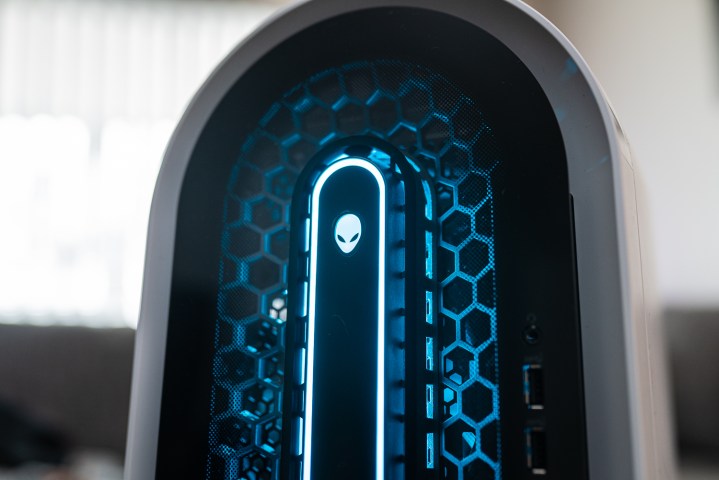
The Aurora R15 looks just like the AMD-exclusive R14 and the Intel-based R13, but it features some critical changes. Externally, it’s the aggressive, undeniable Alienware Legend 2.0 design language: a slanted design with hexagonal vents, alien branding around the machine, and a case available in Alienware’s classic Lunar Light or Dark Side of the Moon color options.
You’ll find the changes internally, and they’re the main draw. Alienware overhauled the cooling solution, and the Aurora R15 now features an optional 240mm all-in-one liquid cooler paired with three additional 120mm fans: two intakes upfront and an additional exhaust in the rear.
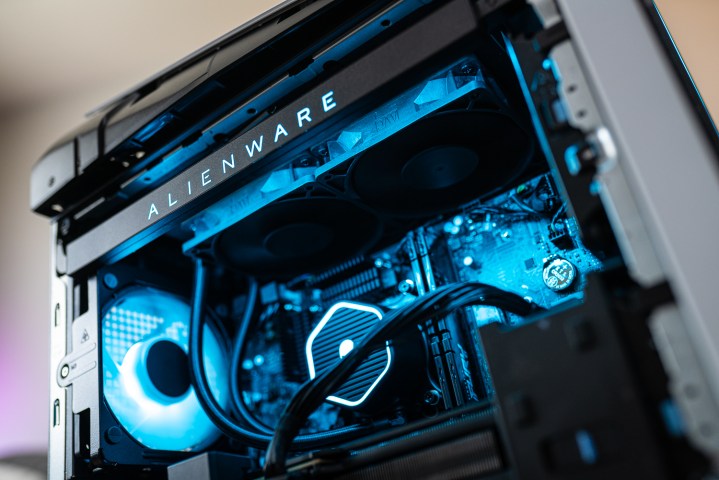
Combined with heatsinks on the motherboard and additional vents in the case, the Aurora R15 runs much cooler and quieter than the previous generation. Even under a demanding Cinebench load or Cyberpunk 2077 run, the Aurora R15 stayed just as quiet as the HP Omen 45L, which means it’s barely noticeable. The CPU stayed cool, too, peaking at around 87 degrees Celsius. That’s chilly for Intel’s latest flagship.
It’s a huge improvement. Alienware desktops have always struggled with thermals and noise, but the Aurora R15 feels like a revelation for the brand in effectively dealing with heat. The downside is that improvements aren’t free. The dreaded 120mm liquid cooler is stock on the AMD configuration, while the Intel build starts with air cooling. You need to upgrade to fully appreciate the improvements Alienware has brought to this machine.
Problematic upgrade choices
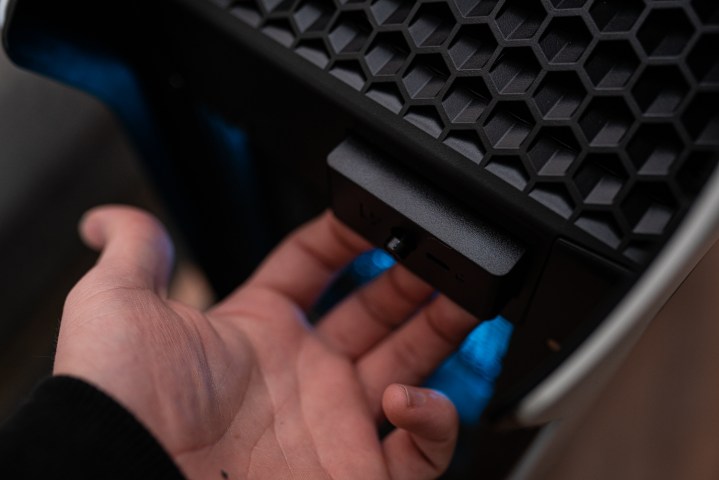
Alienware desktops aren’t usually friendly to upgrades, and the Aurora R15 doesn’t change that. If you want to tinker and upgrade, a custom desktop like the Maingear Vybe offers a lot more flexibility.
Still, there’s a set of buyers who want a desktop that just works. And at the very least, Alienware doesn’t get in the way of servicing the machine. With a single screw and a lever pull, you can take off the side panel and access all of your components. You can dig deeper with Dell’s detailed service manual for the desktop, but you don’t need to. Everything is upfront.
That doesn’t mean it’s easy to access. Alienware locks most of your components down with brackets and plastic tabs that are designed for a service technician and not a DIY PC enthusiast. Simple tasks like removing the graphics card involves several steps in the Aurora R15, and you’ll often have to remove several components to access others. It’s all possible, just not ideal.
Upgrades are still possible — you can swap out the CPU, GPU, RAM, and storage easily, even if there isn’t much of a need with flagship hardware like the RTX 4090.

It’s hard to expand on the Aurora R15, though. For example, the second NVMe SSD slot doesn’t include a thermal pad, despite the fact that it would take only a few minutes to install an additional drive. Alienware is also using a proprietary motherboard design, fit with proprietary connectors, making the chassis useless once the platform has matured past its prime. The server-style power supply limits upgrade potential as well.
The upside to Alienware’s proprietary approach is a dedicated design that limits cable mess and leaves you with exactly what you need. But as with previous Alienware desktops, this one will eventually end up in a recycling pile instead of being carried several generations in the future.
Flagship processor performance
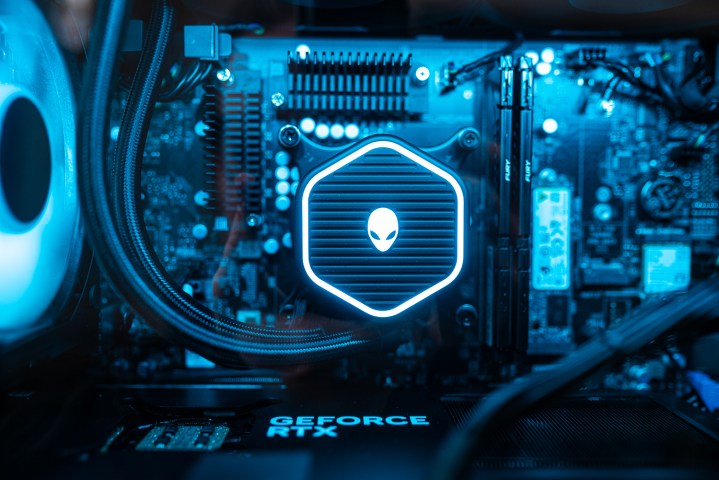
With an Intel Core i9-13900KF, 32GB of DDR5, and an RTX 4090, it’s no surprise that the Aurora R15 is a monster for productivity performance. Compared to last-gen’s Core i9-12900K in the HP Omen 45L, the newer processor dominates in multi-core operations and comes with a significant boost to single-core speed.
The Core i9-13900K is the best processor on the market right now, so the flagship performance doesn’t come as a shock. It’s also a much more capable CPU than gaming chips like the Ryzen 7 5800X3D that shows up in the Falcon Northwest Tiki.
| Alienware Aurora R15 (Core i9-13900KF) | HP Omen 45L (Core i9-12900K) | Falcon Northwest Tiki (Ryzen 7 5800X3D) | |
| Cinebench R23 Multi-Core | 34,3211 | 23,068 | 14,544 |
| Cinebench R23 Single-Core | 2,171 | 1,893 | 1,460 |
| Geekbench 5 Multi-Core | 21,535 | 15,685 | 10,633 |
| Geekbench 5 Single-Core | 2,113 | 1,910 | 1,599 |
| PugetBench for Premiere Pro | 1,309 | 1,025 | 880 |
| Blender Monster (GPU) | 6,500.8 | N/A | 2,809 |
| Blender Junkshop (GPU) | 3,049.3 | N/A | 1,600 |
| Blender Classroom (GPU) | 3,119.9 | N/A | 1,375 |
Your performance will hinge on the processor you put in the machine, but the the Aurora R15 is still a high-end desktop regardless. You have the option between 13th-gen Intel processors or AMD’s latest Ryzen 7000 CPUs, both of which are great options, as well as fast DDR5 memory.
High-end gaming
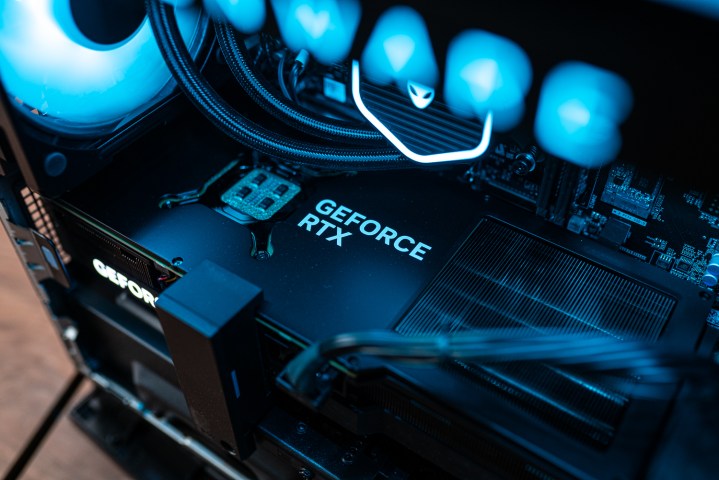
The RTX 4090 is by far the most powerful graphics card you can buy, and it shines in the Aurora R15. In some cases, the Aurora R15 even beat a custom RTX 4090 desktop with an AMD Ryzen 9 7950X, as evidenced by Red Dead Redemption 2.
The same was true in Cyberpunk 2077 and Assassin’s Creed Valhalla, though to a lesser degree. The processor inside the Alienware Aurora R15 is likely boosting the performance here, as well Dell’s excellent thermal management.
Compared to the HP Omen 45L with an RTX 3090, it isn’t close; Nvidia’s latest GPUs blow away the previous generation. However, the Aurora R15 isn’t flat-out better than a custom RTX 4090 desktop.
| Alienware Aurora R15 (RTX 4090) | HP Omen 45L (RTX 4090) | Custom RTX 4090 desktop (Ryzen 9 7950X) | |
| Cyberpunk 2077 (4K Ultra) | 83.2 fps | 44.5 fps | 75.7 fps |
| Cyberpunk 2077 (4K Ultra RT) | 43.1 fps | 21.3 fps | 41.9 fps |
| Red Dead Redemption 2 (4K Ultra) | 127.3 fps | 66.9 fps | 119.2 fps |
| Forza Horizon 5 (4K Ultra) | 151.9 fps | 85.6 fps | 176.3 fps |
| Assassin’s Creed Valhalla (4K Ultra High) | 120.4 fps | 66 fps | 116.7 fps |
| Gears Tactics (4K Ultra) | 136.9 fps | 77.6 fps | 171.7 fps |
| 3DMark Time Spy | 29,597 | 19,113 | 31,409 |
In Gears Tactics, I saw vastly lower performance, likely due to the thermal limits Alienware has set on the processor. Forza Horizon 5 showed slower performance, too, though this game typically favors AMD processors.
Even with a few differences, the Aurora R15 offers performance worthy of the best gaming desktops. The big shame is that Dell isn’t offering AMD’s new RX 7900 XTX as a GPU option. The RTX 4080 and RTX 4090 are supremely powerful GPUs, but they’re also a costly upgrade in the Aurora R15.
Frustrating software
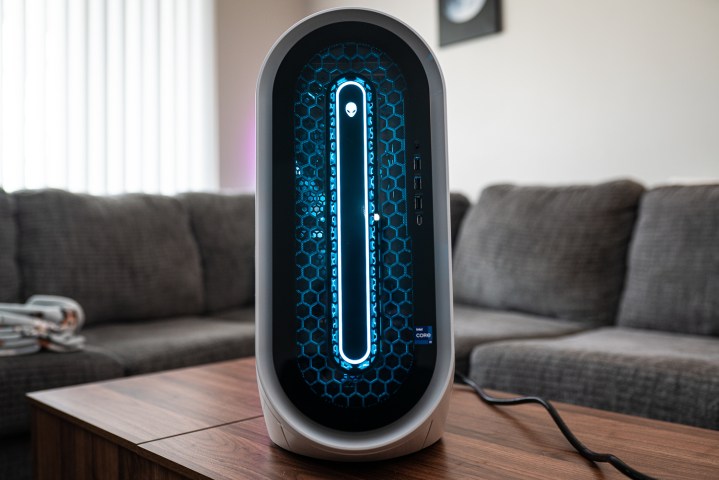
Although extra software is usually a bad thing, Alienware isn’t too intrusive on the Aurora R15. Non-intrusive doesn’t mean helpful, though, and that’s where the Aurora R15 struggles.
When you first boot up the machine, you’re met with the My Alienware app. It’s a hub that links out to Dell SupportAssist for help, manuals to learn your system, and the Alienware Command Center, where you can customize lighting effects and tweak your overclocking settings.
There are around half a dozen Dell and Alienware apps preinstalled on the machine, which is frustrating, but none of them are set to run automatically at startup. My main issue is that Alienware doesn’t point you in the direction that matters.
My Alienware doesn’t list the Alienware Update app that fetches critical updates for your machine, nor Nvidia’s GeForce Experience. My machine arrived with a GPU driver update, as well as a download for the Intel Dynamic Tuning driver. No big deal, GPU driver updates are normal on prebuilt desktops, but nothing notified me of these updates. I had to search for them manually.
Critical updates are ignored, which could easily lead buyers into thinking their expensive gaming desktop is broken.
That was a problem, too. In Cyberpunk 2077, the option for Nvidia’s widely advertised Deep Learning Super Sampling (DLSS) was grayed out, and Premiere Pro refused to load due to the older, preinstalled graphics driver. If you don’t know about driver updates or GeForce Experience, it’s not going to feel good to find critical features don’t work, with no guidance to solve the problem.
With the My Alienware app and the slew of apps that come preinstalled on the system, it’s not hard for Alienware to point you toward critical updates. Instead, they’re ignored, which could easily lead buyers into thinking their expensive gaming desktop is broken when it’s perfectly fine.
Should you buy the Alienware Aurora R15?
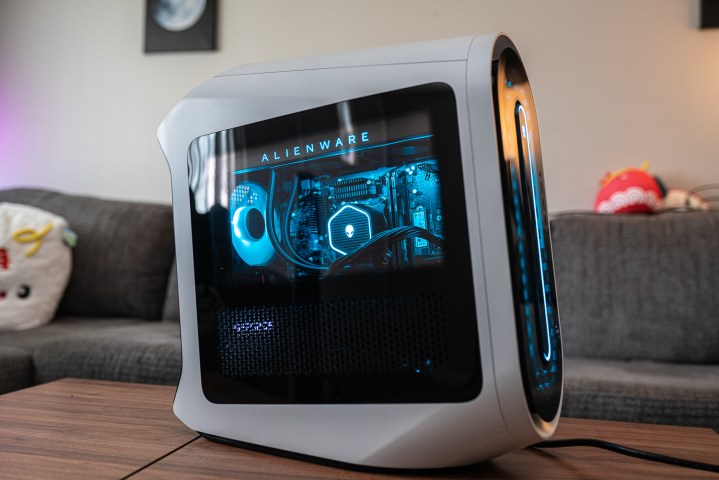
Alienware has long had a problem with proprietary components and expensive pricing, but the R15 revision of the Aurora fixes the biggest issue that has faced Alienware desktops: thermals and noise.
The upgraded cooler is a huge jump for the machine, offering cooler and quieter performance than even many custom-built gaming PCs. Building your own or going with a desktop like the MSI Aegis RS offers more paths for upgradability, but the Aurora R15 still has a place for a set of gamers who want a gaming PC that does exactly what it advertises.




